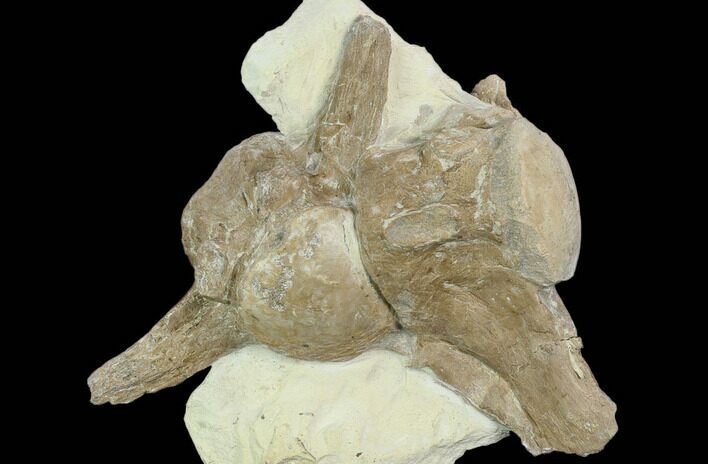This Specimen has been sold.
Two Mosasaur (Tylosaurus) Vertebrae - Kansas
These are two Tylosaurus vertebrae from the Smoky Hill Chalk in Gove County, Kansas. The vertebrae are compressed, though many of the bony landmarks are still easily visible. Some of the processes are still intact, with two that have been repaired. It comes with an acrylic display stand.
Along with plesiosaurs, sharks, fish, and other genera of mosasaurs, Tylosaurus was a dominant predator of the Western Interior Seaway during the Late Cretaceous. Tylosaurus was among the largest of all the mosasaurs, reaching maximum lengths of 14 m (46 ft). A distinguishing characteristic of Tylosaurus is its elongated, cylindrical premaxilla (snout) from which it takes its name and which may have been used to ram and stun prey and also in intraspecific combat.
The Smoky Hill Chalk Member of the Niobrara Chalk formation is a Cretaceous conservation Lagerstätte, or fossil rich geological formation, known primarily for its exceptionally well-preserved marine reptiles. It outcrops in parts of northwest Kansas, its most famous localities for fossils, and in southeastern Nebraska. Large well-known fossils excavated from the Smoky Hill Chalk include marine reptiles such as plesiosaurs, large bony fish such as Xiphactinus, mosasaurs, flying reptiles or pterosaurs (namely Pteranodon), flightless marine birds such as Hesperornis, and turtles. Many of the most well-known specimens of the marine reptiles were collected by dinosaur hunter Charles H. Sternberg and his son George.
Along with plesiosaurs, sharks, fish, and other genera of mosasaurs, Tylosaurus was a dominant predator of the Western Interior Seaway during the Late Cretaceous. Tylosaurus was among the largest of all the mosasaurs, reaching maximum lengths of 14 m (46 ft). A distinguishing characteristic of Tylosaurus is its elongated, cylindrical premaxilla (snout) from which it takes its name and which may have been used to ram and stun prey and also in intraspecific combat.
The Smoky Hill Chalk Member of the Niobrara Chalk formation is a Cretaceous conservation Lagerstätte, or fossil rich geological formation, known primarily for its exceptionally well-preserved marine reptiles. It outcrops in parts of northwest Kansas, its most famous localities for fossils, and in southeastern Nebraska. Large well-known fossils excavated from the Smoky Hill Chalk include marine reptiles such as plesiosaurs, large bony fish such as Xiphactinus, mosasaurs, flying reptiles or pterosaurs (namely Pteranodon), flightless marine birds such as Hesperornis, and turtles. Many of the most well-known specimens of the marine reptiles were collected by dinosaur hunter Charles H. Sternberg and his son George.
SPECIES
Tylosaurus sp.
LOCATION
Gove County, Kansas
FORMATION
Niobrara Formation
SIZE
6.3 x 6.2"
CATEGORY
SUB CATEGORY
ITEM
#130551
We guarantee the authenticity of all of our specimens.
 Reviews
Reviews
















